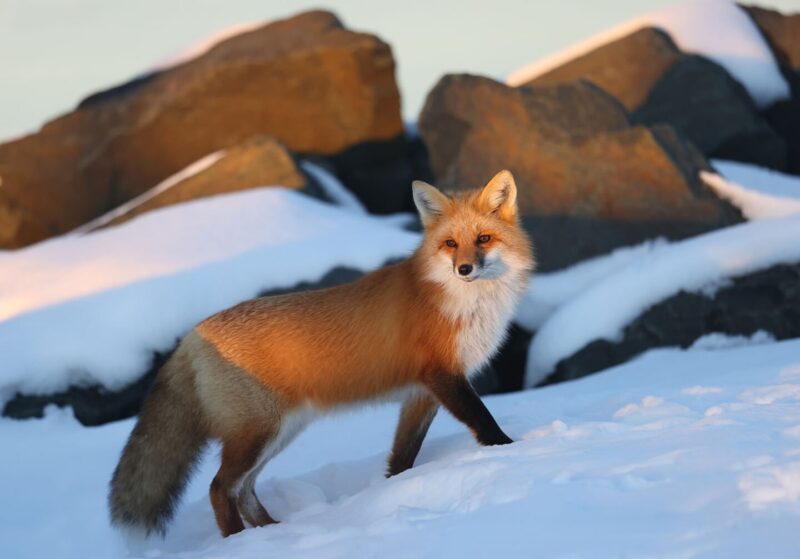Ever wondered what a red fox does when the snow starts falling? Unlike us, they can’t just turn up the thermostat or layer on another cozy sweater. Yet, these clever creatures have mastered winter survival in ways that might make even the most seasoned winter survivalist raise their eyebrows in admiration.
I recall a winter morning when I saw a lone red fox, looking as comfortable as if it was lounging by a fireside. I was intrigued to find out how’s that possible. Today I’ll talk about what I’ve found out.
Brief Overview
| Key Information | Description |
|---|---|
| Species Name | Red foxes (Vulpes vulpes) |
| Habitat Range | Found across the entire Northern Hemisphere, from the Arctic tundra to North Africa. |
| Adaptability | Able to adapt to a wide range of environments, including forests, grasslands, mountains, and even urban areas. |
| Winter Challenges | Red foxes, like other wildlife, face challenges during winter, including reduced daylight, plummeting temperatures, and scarcity of food. |
| Survival Strategies | During winter, they employ strategic hunting and foraging, undergo physiological adaptations, and sometimes exhibit collaborative behaviors for mutual survival. |
| Metabolic Changes | Winter affects their metabolism and energy usage as they adapt to the cold. |
| Impact on Social Structures | The harsh winter season can influence their social structures, encouraging more collaborative behaviors among red foxes for mutual survival. |
Winter Coat Adaptation
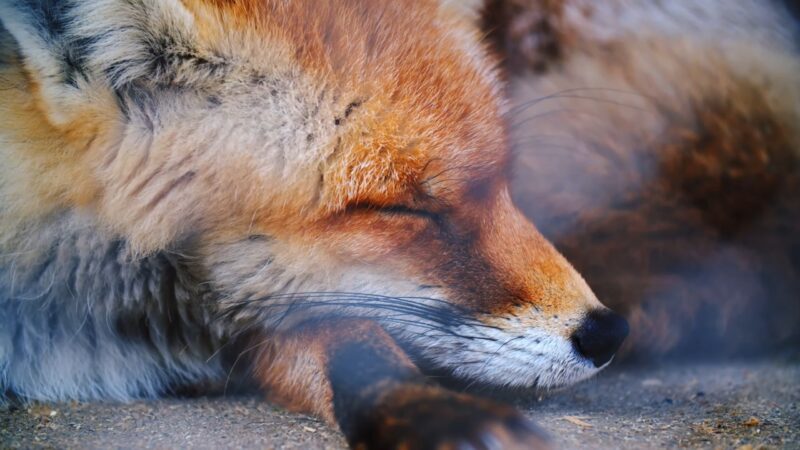
As the chill of winter sets in, the red fox’s coat undergoes a remarkable transformation. It becomes thicker and fluffier, providing much-needed warmth. This luxurious coat comes in various shades, from deep reds to golden hues, helping them blend into the winter landscape.
Notably, the fur on their paws thickens as well, offering protection against the cold ground and aiding in silent movement across snowy terrain.
Insulation and Warmth
The multi-layered fur of red foxes is an exceptional adaptation for insulation. The dense undercoat traps warm air close to their skin, while the longer guard hairs repel water and snow, keeping them dry. This dual-layered system is crucial for maintaining a stable body temperature, allowing red foxes to be active even in sub-zero conditions.
Furthermore, the fur-covered ears and bushy tail, which can be curled around the body, play a significant role in preserving heat.
Molting Process
The molting process, occurring as the seasons change from winter to spring, is both a practical and fascinating aspect of the red fox’s life cycle. During this time, they shed their dense winter fur, making way for a lighter coat suitable for warmer weather.
This process is not just a simple shedding of fur; it is a gradual and strategic transition that ensures the fox is not left vulnerable to temperature changes. Additionally, the new coat that emerges is not only lighter but also brighter, reflecting the shift in their environment and activities.
Hunting Strategies
Winter calls for a change in tactics. With snow covering the ground, red foxes rely more on their acute hearing to locate prey under the snow. This heightened auditory ability allows them to detect the faintest sounds of movement beneath the snow’s surface.
They position themselves precisely above their target before striking, demonstrating remarkable spatial awareness in a seemingly blank landscape. This skill is especially critical in deep snow, where visual cues are minimal.
Prey Availability
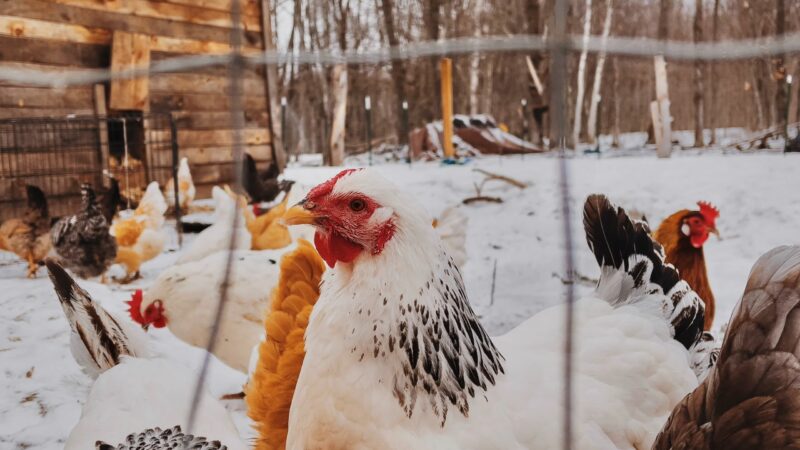
Food sources change in winter, with small mammals like voles becoming a primary target. These creatures tunnel under the snow, a fact that red foxes ingeniously exploit. In addition to voles, they also adapt their diet to include birds, insects, and even carrion during the leaner months.
The diversity in their diet highlights their adaptability and resilience in the face of seasonal changes. This adaptability ensures that red foxes have a consistent food supply throughout the winter, despite the scarcity of traditional prey.
Stealth and Patience
Hunting in winter requires patience and stealth. Red foxes are known for their iconic hunting leap, a calculated dive into the snow to catch unsuspecting prey. This leap, often captured in wildlife photography, is a testament to the precision and timing of these predators.
They often remain motionless for extended periods, conserving energy before making their calculated pounce. This hunting method is not only efficient but also conserves valuable energy in the cold environment.
Food Storage Techniques
Red foxes often store surplus food. This foresight ensures they have a backup when hunting is tough. These reserves are particularly vital during severe weather conditions when hunting opportunities are limited. By burying food in various spots, they create a network of resources across their territory.
This behavior also demonstrates an understanding of future needs and a sophisticated level of cognitive ability in wildlife.
Food Caches
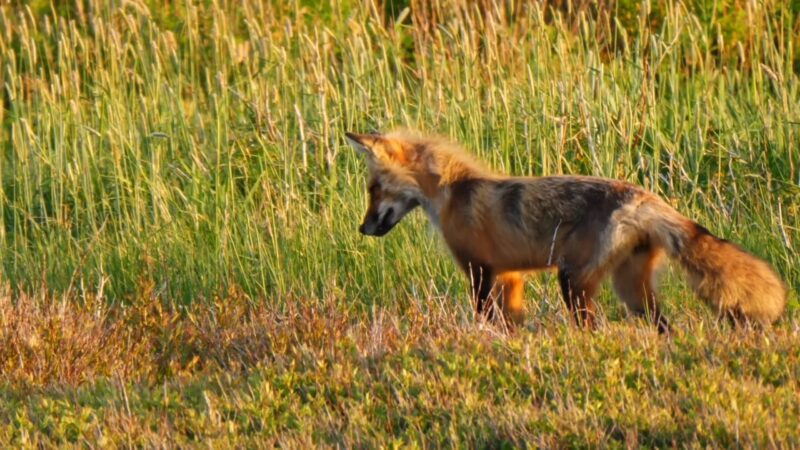
They create food caches, burying food in various locations. This technique is a critical survival strategy in the harsh winter months. The caches are strategically placed, often near their dens or in areas they frequently visit. This ensures easy access during times of need, especially when heavy snowfall covers the landscape.
The act of caching also helps prevent theft from other predators, securing their hard-earned meals for future use.
Keen Sense of Smell
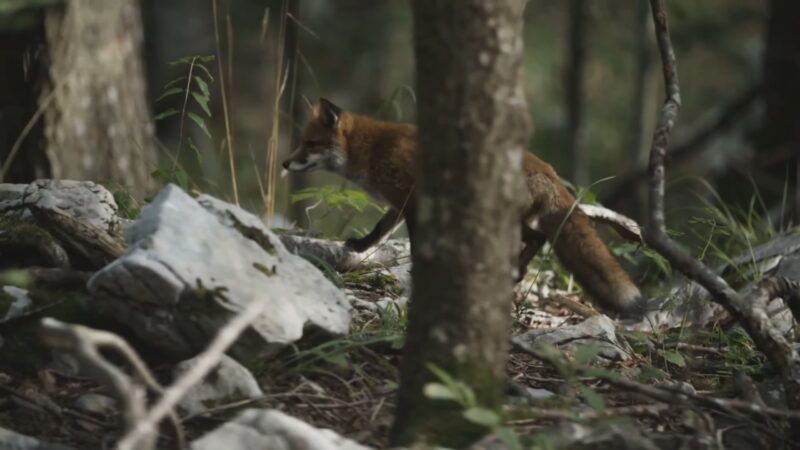
Their sharp sense of smell guides them to these hidden food stores, even under a thick blanket of snow. This olfactory capability is crucial in winter, as visual landmarks are often obscured. Interestingly, red foxes can differentiate between their caches and those of other foxes, avoiding potential conflicts.
This skill also aids in locating new food sources, as they can detect the scent of small animals or carrion from a considerable distance.
Shelter and Denning
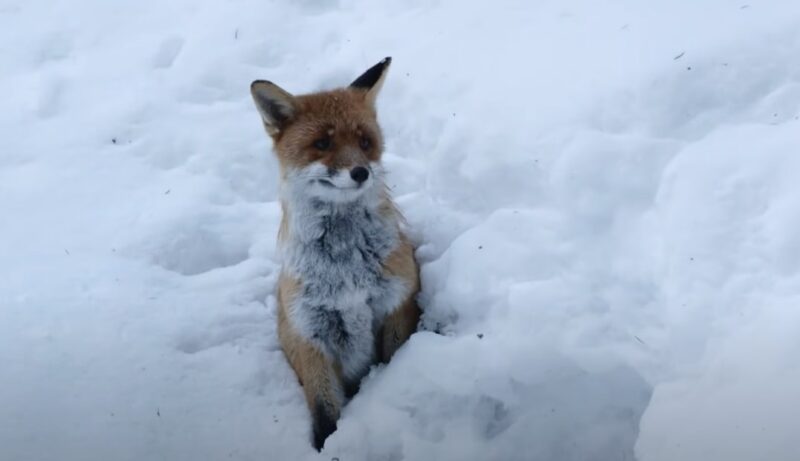
Dens offer refuge from the cold. Red foxes either dig new dens or refurbish old ones, often located on slopes to avoid snow accumulation. These dens are constructed with multiple exits and entrances, providing escape routes from predators. The strategic location of these dens also ensures exposure to sunlight, providing some natural warmth.
Moreover, the depth and structure of the dens are meticulously planned to prevent flooding and ensure stability. Dens are more than just a shelter; they are nurseries for pups and a haven from predators. They provide a safe environment for raising their young during the vulnerable early months of life.
The dens also play a role in the social dynamics of fox families, as they serve as a central meeting point. Additionally, these structures offer protection against the harsh winter winds, keeping the foxes relatively warm and dry during snowstorms and freezing temperatures.
Denning Behaviors
Red foxes often line their dens with leaves and grass for additional insulation, showcasing their resourcefulness. This behavior not only adds comfort but also aids in controlling the internal temperature of the den. The materials used for lining are frequently replaced to ensure cleanliness and prevent parasites.
In addition to lining their dens, red foxes are known to take advantage of natural hotspots, such as geothermal areas or sunlit patches, to warm themselves and their young. This instinctual behavior further demonstrates their ability to adapt and utilize their environment for survival.
Social Structure and Cooperation
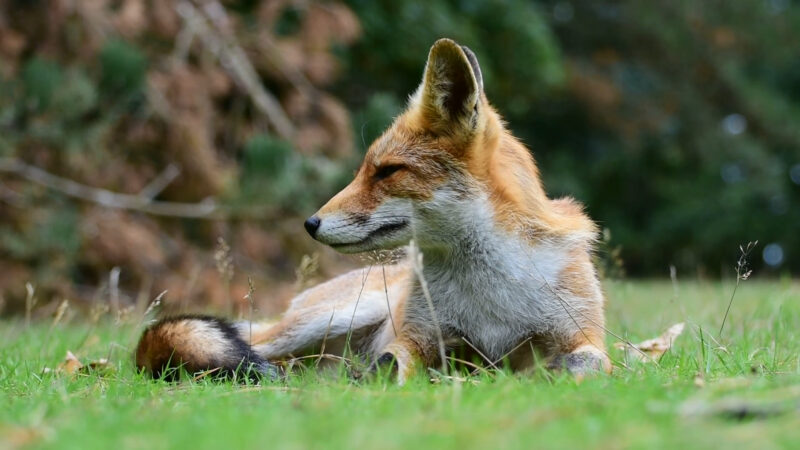
Social Behaviors
Winter can foster unique social behaviors. While generally solitary, red foxes may show increased cooperation during this season. This shift is particularly noticeable in areas where food is scarce, prompting a need for more coordinated efforts in foraging.
Interestingly, these cooperative behaviors seem to extend beyond immediate family members, suggesting a more complex social dynamic than previously thought. This adaptability in social behavior underscores the fox’s ability to modify its survival strategies in response to environmental pressures.
Family Groups
Family units play a crucial role. Pairs or small family groups can often be seen foraging or defending territory together. This group dynamic not only increases the efficiency of hunting but also enhances the protection against predators.
In some cases, older offspring from previous seasons will remain with the family unit to assist in raising new litters, demonstrating a level of familial loyalty and cooperation. The strength of these family bonds is a key component of the red fox’s ability to survive in harsh winter environments.
Interaction with Offspring
Mates and offspring share responsibilities, from hunting to den maintenance, underlining the importance of familial bonds. These interactions are crucial for the survival of the young, as they learn vital survival skills through observation and imitation.
The division of labor between parents allows for a more efficient management of resources and care for the pups. This cooperative parenting approach ensures a higher survival rate for the offspring, securing the future generation of the species.
Energy Conservation
Surviving winter isn’t just about staying active; it’s also about conserving energy. Red foxes reduce their activity levels to save energy. By limiting their movements, they minimize the calories expended and can survive longer on their stored fat reserves.
This strategy is particularly important during periods of food scarcity when every calorie counts. It’s a fine balance between staying active enough to find food and not expending too much energy in the process.
Torpor and Reduced Activity
They may enter a state of light torpor, lowering their metabolic rate to conserve energy during extreme cold spells. This torpor is not as deep as hibernation, but it allows the fox to conserve energy without becoming completely inactive.
During these periods, their body temperature, heart rate, and respiratory rate decrease. This physiological adaptation is crucial for survival in the coldest months when food is scarce and the need to conserve energy is paramount.
Metabolic Adaptations
These metabolic adjustments are crucial for surviving long periods without food, a common winter challenge. Red foxes have evolved to have a more efficient use of their fat stores, optimizing their energy consumption.
Their liver plays a key role in this process, regulating the metabolism and ensuring that energy is released as needed. This ability to manage their internal resources efficiently is a testament to the red fox’s evolutionary success in varied and often harsh climates.
How Do They Avoid Extreme Cold?
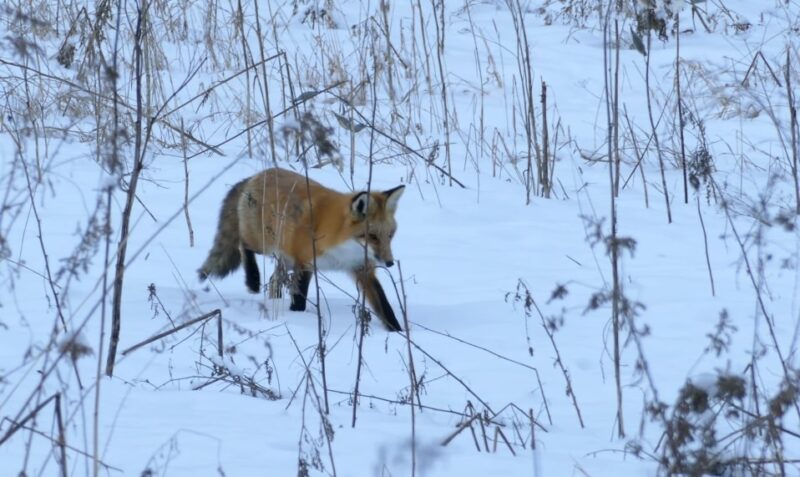
1. They Minimize Exposure
Red foxes are adept at minimizing exposure to severe weather. They seek shelter during the worst of the winter storms. By finding refuge under dense vegetation, rock crevices, or abandoned burrows, they can significantly reduce their exposure to the elements.
This behavior not only protects them from the cold but also from the increased risk of predation during these vulnerable times. Their ability to identify and utilize various forms of natural shelter is a key survival skill during the winter months.
2. Making Snow Tunnels and Cover
Using snow tunnels and natural covers like thickets and tree roots, they protect themselves from the elements. These tunnels also serve as strategic pathways for hunting, allowing them to move stealthily and conserve energy.
The insulation provided by snow can surprisingly be warmer than the frigid air temperatures above, turning these tunnels into cozy hideaways. Moreover, these structures provide a strategic advantage, offering an element of surprise against their prey.
3. Behavioral Adaptations
From curling up to reduce body surface area exposed to the cold to huddling with family members, these behavioral adaptations are key. They often find sunny spots during the day to bask in, which helps raise their body temperature naturally.
Additionally, red foxes are known to use their bushy tails as a blanket, covering their faces and bodies to retain heat. These simple yet effective behaviors are a testament to the red fox’s ability to adapt and find creative solutions to the challenges posed by cold environments.
What About Limited Resources?
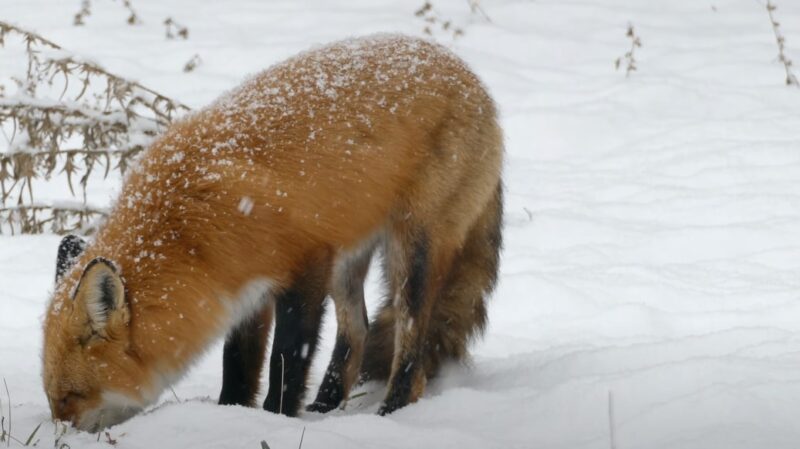
Winter dramatically reduces the availability of food. Red foxes adapt by expanding their diet to include fruits, insects, and even carrion. This dietary flexibility ensures they have a wider range of options when traditional prey is scarce. They are also known to visit human settlements in search of food, showcasing their adaptability to different environments. This opportunistic feeding habit is crucial for their survival during the lean winter months.
Adjusting Diets and Feeding Habits
Flexibility in the diet is a survival trait. They shift from being primarily hunters to opportunistic foragers, consuming whatever is available. This includes scavenging on leftovers from other predators or human sources.
In times of extreme scarcity, red foxes might also eat vegetation, although this is less common and not as nutritionally beneficial. Their ability to switch feeding strategies based on availability is a key factor in their survival during winter.
Interaction with Other Animals
In their quest for food, red foxes might interact with other animals, either in competition or, rarely, in a form of mutual tolerance. These interactions can range from confrontations over territory and food sources to more passive coexistence.
Sometimes, red foxes can be seen following larger predators like wolves, hoping to scavenge from their kills. These interactions highlight the complex dynamics of the ecosystem in which red foxes live, and their ability to navigate and adapt to these dynamics is essential for their survival.
Predators and Threats
Winter doesn’t just bring cold but also predators. Wolves, eagles, and even humans pose significant threats. These predators are more active and visible in the winter landscape, forcing red foxes to be more vigilant and cautious. The scarcity of vegetation for cover makes them more vulnerable, requiring them to be strategic in their movements.
Besides predators, red foxes face dangers from starvation, severe weather, and diseases, which are exacerbated in winter. The harsh conditions can weaken their immune system, making them more susceptible to illnesses. Starvation remains a constant threat due to the scarcity of food, and severe weather can lead to hypothermia or frostbite.
These challenges require red foxes to be resilient and resourceful in their survival strategies.
Evasion Strategies
Red foxes employ various strategies to evade threats, from stealth and camouflage to swift retreats into their dens. Their reddish-brown fur provides excellent camouflage against the winter terrain, especially during sunrise and sunset.
They are also incredibly agile, capable of quick escapes when threatened. Their intelligence and adaptability are key in outwitting predators and overcoming the myriad of challenges they face in winter.
Impact of Human Activities
Human activities can both help and hinder red foxes’ winter survival. Urban areas can provide food sources, but also dangers like road traffic. The encroachment of human settlements into their natural habitats forces red foxes to navigate a landscape that is both a source of sustenance and danger.
This interaction with humans and human-modified environments is a testament to their adaptability but also highlights the challenges they face due to human activities. In urban settings, red foxes face road hazards and potential conflicts with humans, testing their adaptability.
The allure of easy food sources like garbage bins can draw them into risky areas. Road traffic poses a significant threat, as red foxes may not always recognize the danger posed by vehicles. This intersection with human environments requires them to constantly adjust their survival strategies.
FAQs
Do red foxes hibernate during winter like some other animals?
No, they don’t. Unlike some mammals that hibernate to conserve energy during the cold months, red foxes remain active throughout the winter. They continue to hunt, forage, and engage in social behaviors, despite the harsh conditions.
Can red foxes swim, and do they use this ability to find food in winter?
Yes, these animals are capable swimmers. Although it’s not their primary method of hunting, they can swim to hunt for food or escape predators. In winter, they might swim to access food sources or territories that are otherwise unreachable due to snow and ice.
How do red fox pups born in the spring survive their first winter?
Pups born in the spring spend their first few months growing and learning essential survival skills from their parents. By the time winter arrives, they are usually capable of hunting and foraging independently. The skills and behaviors learned from their parents are crucial for their survival through their first winter.
Are red foxes more prone to diseases in winter?
Winter can be a challenging time for these animals, as the harsh conditions can weaken their immune systems, making them more susceptible to diseases. However, their adaptability and survival strategies help them to cope with these increased risks.
Do red foxes have a specific mating season, and how does it align with winter?
These animals typically mate in the late winter, around January or February. This timing ensures that the pups are born in the spring when the weather is milder and food is more abundant, which increases their chances of survival.
How does snow depth affect red foxes’ hunting strategies in winter?
Deep snow can both hinder and help their hunting. It makes it more challenging to move quickly and spot prey. However, red foxes are adept at using the snow to their advantage by listening to the movements of prey under the snow and using their characteristic pounce to catch them. Deep snow also hides these animals from their prey, allowing them to approach undetected.
Final Thoughts
As we’ve seen, red foxes are excellent at surviving in winter. Their special features and smart hunting methods help them thrive in cold conditions. Remember to protect their homes, as it’s not just about nature but also about supporting their ability to survive harsh winters.


